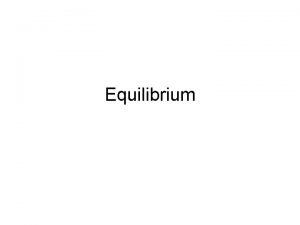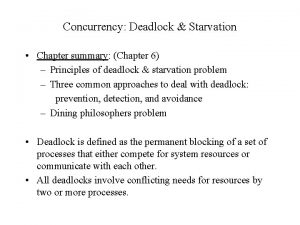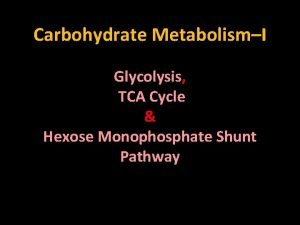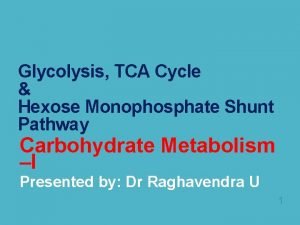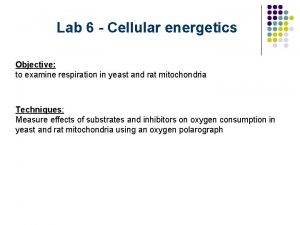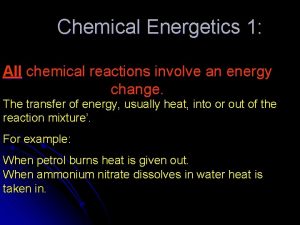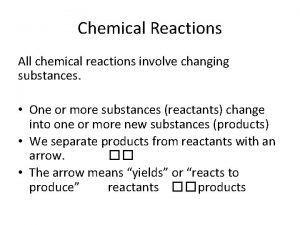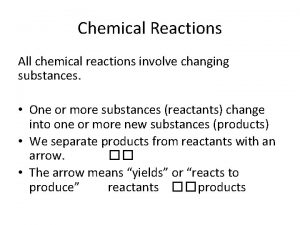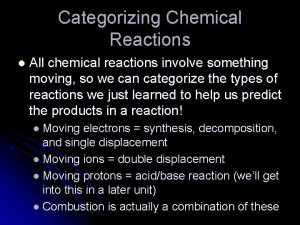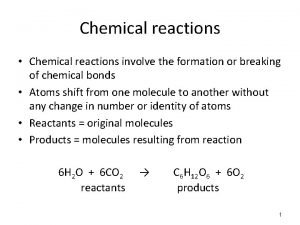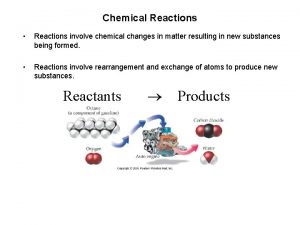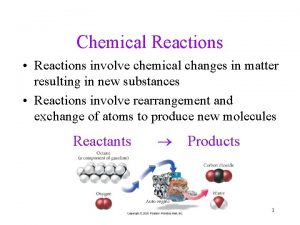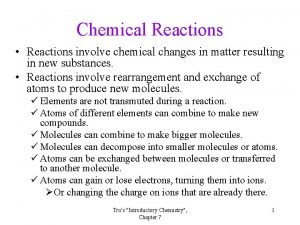Chemical Energetics 1 All chemical reactions involve an













- Slides: 13

Chemical Energetics 1: All chemical reactions involve an energy change. The transfer of energy, usually heat, into or out of the reaction mixture’. For example: When petrol burns heat is given out. When ammonium nitrate dissolves in water heat is taken in.

Energetics 2: As chemists are lazy people instead of writing ‘energy change’ all the time they use the symbols: H Pronounced ‘delta aitch’. =greek letter ‘delta’ meaning change. H=heat. So, H means ‘heat change’.

Temperature Changes 1 Some reactions cause the temperature of the reaction mixture to increase. This type of reaction is called exothermic. Heat energy is given out by the reaction mixture hence the surroundings increase in temperature.

Temperature Changes 2 Some reactions cause the temperature of the reaction mixture to decrease. This type of reaction is called endothermic. Heat energy is taken in by the reaction mixture hence the surroundings decrease in temperature.

Representing Energy Changes: The energy changes in a chemical reaction can be conveniently represented using energy level diagrams Energy level diagrams make it easier to decide whether a reaction is exothermic (gives out heat and gets hotter) or endothermic (takes in heat and gets cooler). See next slide for some examples.

Energy Level Diagrams This energy level diagram shows a reaction where H is negative (an exothermic reaction). This energy level diagram shows a reaction where H is positive (an endothermic reaction). Reactants Products energy H negative, exothermic. Products H positive, endothermic. Reactants

Making and Breaking Bonds: Making chemical bonds is always exothermic. Breaking chemical bonds is always endothermic. All chemical reactions involve bond ‘rearrangements’. Bonds are broken and new ones are formed. Chemical reactions are in two stages: 1. Breaking bonds, an endothermic process. 2. Making new bonds, an exothermic process.

Reaction Profiles: These are a more detailed version of the energy level diagrams previously looked at. They show the endothermic bond breaking and the exothermic bond making stages of a reaction. Reaction profiles can be used to do numerical calculations on the energy changes that happen in chemical reactions. The next slide shows the energy profile for the reaction between hydrogen and chlorine to form hydrogen chloride.

Reaction Profile for: H 2 + Cl 2 2 HCl Energy taken in to break bonds. H, H, Cl (Atoms) Energy given out when bonds are made. energy H-H, Cl-Cl Reactants Overall energy change, H H-Cl, H-Cl Products

Calculating Energy Changes: The energy change for a reaction can be calculated using ‘bond energies’. ‘Bond energy’ is the amount of energy required to break a bond. This value is always endothermic, endothermic ie. has a positive value. When a bond is formed the energy given out is exactly equal to, but of opposite sign, to the energy required to break the bond. Bond making is always an exothermic process. .

An Example Calculation: Consider the reaction between hydrogen and chlorine: to see the reaction profile. H 2 + Cl 2 2 HCl In this reaction one H-H bond and one Cl-Cl bond is broken and two H-Cl bonds are formed. The H-H bond energy is 436 k. J/mol The Cl-Cl bond energy is 242 k. J/mol So, the energy needed to break these bonds is 436 + 242 = 678 k. J The H-Cl bond energy is 431 k. J So the energy given out when these bonds are formed is 2 x -431 = -862 k. J Overall change = 678 – 862 = -184 k. J, an exothermic reaction. Next slide shows the reaction profile with these values added.

Reaction Profile for: H 2 + Cl 2 2 HCl Energy in = +678 k. J H, H, Cl (Atoms) Energy out = -862 k. J energy H-H, Cl-Cl Reactants Overall energy change, H = -184 k. J H-Cl, H-Cl Products

Summary Endothermic reactions get cold, they take in heat. Exothermic reactions get hot, they give out heat. Bond breaking is endothermic, bond making is exothermic. Chemical reactions take place in two stages: 1. An endothermic bond breaking stage. 2. An exothermic bond making stage. The energy changes in a chemical reaction can be represented using energy level diagrams and reaction profile diagrams.
 Section 2 reinforcement classifying chemical reactions
Section 2 reinforcement classifying chemical reactions Section 2 classifying chemical reactions worksheet answers
Section 2 classifying chemical reactions worksheet answers Chemical reactions section 3 reactions in aqueous solutions
Chemical reactions section 3 reactions in aqueous solutions Are all chemical reactions reversible
Are all chemical reactions reversible Chemical reactions section 1 chemical changes
Chemical reactions section 1 chemical changes Chapter 18 chemical reactions balancing chemical equations
Chapter 18 chemical reactions balancing chemical equations Reduction half reaction
Reduction half reaction Unit 5 chemical reactions answers
Unit 5 chemical reactions answers Deadlock summary by chapters
Deadlock summary by chapters Significance of hmp shunt in biochemistry
Significance of hmp shunt in biochemistry Glycolysis energetics
Glycolysis energetics Tca energetics
Tca energetics Azide electron transport chain
Azide electron transport chain Energetics power tower 180
Energetics power tower 180



